Comic Book Confidential: Green Lantern / Green Arrow Team
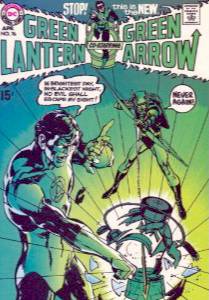
The iconic cover of Green Lantern #76 and the first Green Lantern / Green Arrow team-up!
The Silver Age Green Lantern had enjoyed a very successful comic book run throughout almost the entire decade of the 1960’s. As the 70’s rolled in, readers began to grow tired of the colorfully drawn tales of heroics that seemed to have black and white morals. The emerald ring slinger’s book was one of many titles that were facing cancelation due to poor sales and stale repetitive stories. Editor Julius Schwartz took a major gamble by turning the title over to the young duo of writer Denny O’Neil and artist Neil Adams who had a daring plan to give the comic something that had seldom been seen in the format up to that time – social relevance!
The character of Green Lantern was essentially that of a galactic policeman. Working as a member of the Green Lantern Corps under the authority of the Guardians of the Universe, he maintained law and order throughout his sector of space – of which his home plane Earth was only a small portion. Using his power ring, he could create almost anything he could imagine and as long as it was not used on anything yellow and recharged every twenty-four hours, this power was essentially limitless. This may seem like a great setup for a superhero but there are only so many ways to create tension when your protagonist is so formidable. Green Lantern was also naïve in many ways, giving little thought to the reasoning behind the rules he upheld or his effectiveness in doing so. The character was ripe for a major downfall coupled with a heavy infusion of moral integrity but the series needed someone to be the voice of these viewpoints and they found him in the similarly garbed but ethically conflicting Green Arrow.
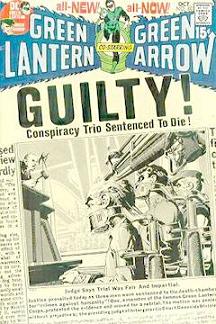
Issue 80 shows one of the typically unique cover designs from the revamped series
Making his debut in More Fun Comics #73 in November of 1941, Green Arrow appeared on the scene not too long after the Golden Age Green Lantern. He was initially a thinly veiled copy of DC’s popular Batman character merely substituting a bow and quiver full of trick arrows in place of a gimmick laced utility belt. Like the caped crusader’s alias Bruce Wayne, Oliver Queen was also a rich playboy who used his archery skills to survive when he was shipwrecked on a deserted island then decided to use them to fight crime as Green Arrow after he was rescued. He had an Arrowcar and Arrowplane and even adopted an orphan named Roy Harper who became his sidekick Speedy. Holy copycats Batman!
Green Arrow was one of the few DC heroes to make the transition between the Golden and Silver Ages unchanged. He would not receive a major overhaul until 1969 when Neil Adams redesigned his costume to make him look more like a modern version of Robin Hood. Continuing this theme, Denny O’Neil had the character fall on hard times and lose almost all of his personal fortune due to some shaky business deals. The resulting change exposed the archer to social injustices he had previously overlooked and he vowed to become a champion for the underprivileged. O’Neil was eager to continue developing Green Arrow’s social consciousness but since the character had never had his own title, pairing him with the faltering Green Lantern seemed like the next best thing.
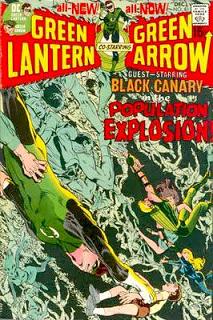
The population explosion (on a distant planet, not Earth) was one of the many topical issues the series commented on
The cover of Green Lantern #76 was a real shocker to fans who had been lulled into a trance by the book’s recent lackluster issues. In addition to a logo change that now dubbed the comic Green Lantern / Green Arrow (with a small “co-starring” designation before the latter’s name), the now iconic cover showed Green Arrow destroying Green Lantern’s power battery with a well placed arrow and interrupting the ring slinger’s oath by shouting “never again”. The story inside actually lived up this bold introduction as it told the tale of Green Lantern misinterpreting a situation and saving a dishonest businessman from an understandably upset mob. After Green Arrow sets him straight, he offers to show him some of the injustices being committed all around him and Green Lantern is later berated by an African-American man for protecting alien races of all colors but not the discriminated people of his own planet.
Green Lantern has his eyes opened to the problems rampant in his own back yard but his attempted interventions anger the Guardians since the people he seeks to punish have not broken any laws themselves. Green Arrow steps in and chastises the Guardians for being too far removed from the problems they seek to correct and manages to convince them to take a closer look at the beings they protect. Green Lantern takes a leave of absence from his duties with the Guardians who respond by reducing his ring to half of its previous power and no longer protects him automatically from mortal danger (a wonderful move to create more dramatic stories). At the conclusion of the issue, Hal Jordan and Oliver Queen begin a cross country road trip to get in touch with America and find themselves in the process.
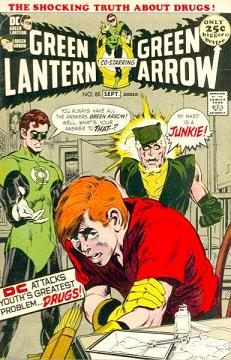
One of the most shocking covers in comic book history was Green Lantern / Green Arrow #85
For the next several issues, Green Lantern and Green Arrow battle a new breed of villains – racists, cult leaders, drug dealers and corrupt politicians. Eventually some of the old enemies like Sinestro and the Black Hand pop up as a change of pace with a little social commentary thrown in for good measure. Along the way, Green Arrow’s romantic interest Black Canary and Carol Ferris drop in and out to complicate matters and usually fall victim to the stories’ villain. To add to the emotional depth and character conflict, Black Canary never used her recently acquired sonic cry powers and was searching for her own place in the world after the recent death of her husband and migration from Earth-2 to Earth-1. Carol Ferris was crippled by one villain and it was unclear if her continued paralysis was physical or psychosomatic but the end result took a heavy toll on Green Lantern who felt responsible for her injuries.
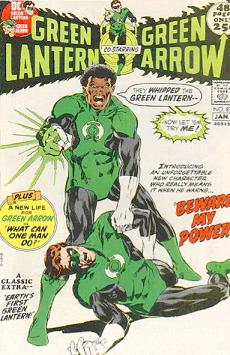
African-American Lantern John Stewart made his debut in issue #87 shortly before the series was canceled
While the sales of the magazine improved significantly at first, the novelty of socially relevant stories began to wear off quickly. The innovative tales bought the book a brief reprise but it was ultimately canceled after issue 89. This was not before O’Neil and Adams managed to publish two outstanding stories that would have long reaching effects in the DC universe. In issues 85 and 86, the duo not only tackled the drug problem on the streets but in their own lives as well. It is revealed that Green Arrow’s ward Speedy, whom he thought was working undercover to bust a drug ring, is himself a heroin addict. The teen tells a painful tale of how he felt abandoned by his mentor and sought comfort in illegal drugs. He is eventually able to kick the habit with the help of Black Canary but he and Green Arrow would never have the same relationship again. This was powerful stuff for comic books in the early 70’s and the story won several industry awards. The next issue, number 87, introduced alternate Green Lantern John Stewart, a fiery tempered African-American with a chip on his shoulder. His transition into a full fledged Green Lantern was a difficult one but he would eventually overcome his own issues to champion the greater good.
Following the book’s cancellation in 1972, one final finished tale was serialized as a back up story in Flash comics and then the emerald duo went back to being supporting characters in other comics like Justice League of America. It would only be a short hiatus of less than four years before the series was reinstated with issue number 90 in 1976 and Green Arrow returned with it. He would remain a co-star until issue 123 when the title reverted to solo stories of Green Lantern and he was moved to World’s Finest comics for his own solo shot. The later 70’s Green Lantern / Green Arrow stories were more traditional tales of superhero adventures that either down played or completely eliminated the socially conscious elements to cater to the perceived current audience. The book had already made its mark though as it helped to usher in what became known as the Bronze Age of comics when stories became more realistic and placed greater emphasis on the human aspects of superheroes. Even close to forty years after the last issue of the initial Green Lantern / Green Arrow run was published, these stories still hold up remarkable well and are recommended comic book reading.
